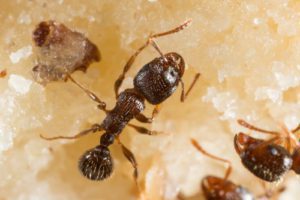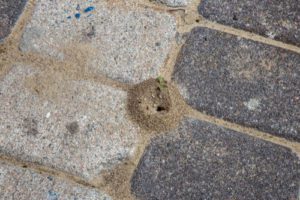YOU DON’T HAVE TO PUT UP WITH FORAGING ANTS!
By Chris Williams on May 6, 2019.
In the last week, I’ve been seeing some small, black ants in our downstairs family room. I didn’t notice them all winter long but now I’m remembering that we saw some similar ants last summer. Do you think they’re nesting in the house somewhere? I think they’re too small to be carpenter ants. K. V., Pepperell, MA
K. V., Pepperell, MA

Close up on Pavement Ants. Shutterstock.
We can’t rule out an indoor nest without a professional inspection, but chances are good that these are outdoor-nesting ants that are actively foraging now that the weather is getting warm. They’ve found their way into your house in their search for food that they’ll take back to their outdoor nest.
PAVEMENT ANTS ARE COMMON INVADERS
While there are lots of little dark ants, pavement ants are a distinct possibility. As their name implies, they generally nest outside beneath hard, paved surfaces such as sidewalks, brick walkways, driveways, stonewalls, and foundation slabs where they push sand and debris out through cracks, leaving little piles to mark their underground activity. Although pavement ants live outside or around the foundation, they very often find their way into homes and other structures in search of food (see Winter Clean Up Starts When Pavement Ants Awaken…).
Pavement ants, like many other ants, follow definite trails to and from food sources so you may find them following along a baseboard from a basement door to a pet’s food dish or a bag of grass seed. These ants are actually pretty easy to identify if you have a magnifying lens. They have rows of grooves or furrows on the top of their head and back.
ANT TRAILS AND ANT BAITS GO TOGETHER
Ants are very ambitious, they are always foraging, looking for new food sources to feed the colony. If they find a way into your house, it becomes part of the search zone. Once they find an available food source, ants recruit other members of the colony by leaving pheromone scents along a trail between the nest and the food. We can use this trailing behavior to our advantage since existing trails are the perfect location for ant baits. We can often eliminate ants, even those nesting inside, with a planned baiting program. Foraging ants find the bait placements and carry the toxic bait back to the colony to feed others.
ANTS MAY BE SHORT-TERM OR LONG-TERM VISITORS

Pavement ant mound/hill on a patio. Shutterstock.
With foraging ants of any type, you never know how long they’re going to be around. If they’re not nesting inside, you may see them for only a couple of days or they may visit on a regular basis for months. Sometimes ants also move inside when weather conditions outside are less than desirable, and then move back outside later, usually looking for more moisture than they get indoors.
If ants fail to locate, or if they exhaust, an indoor food source, they may leave your house for good. Or, if they find a particularly persistent food source such as a refilled pet bowl, they may forage into your home over a long period of time unless deterred. If they find food at one place in your home, expect them to expand their search range and end up in your kitchen or pantry as well.
Give Colonial Pest a call. Our experts can determine the species of ants and whether they are nesting inside or outside. We can implement controls that will eliminate the foragers and keep ants out, guaranteed!
For more on pest ants, see these Colonial blogs: